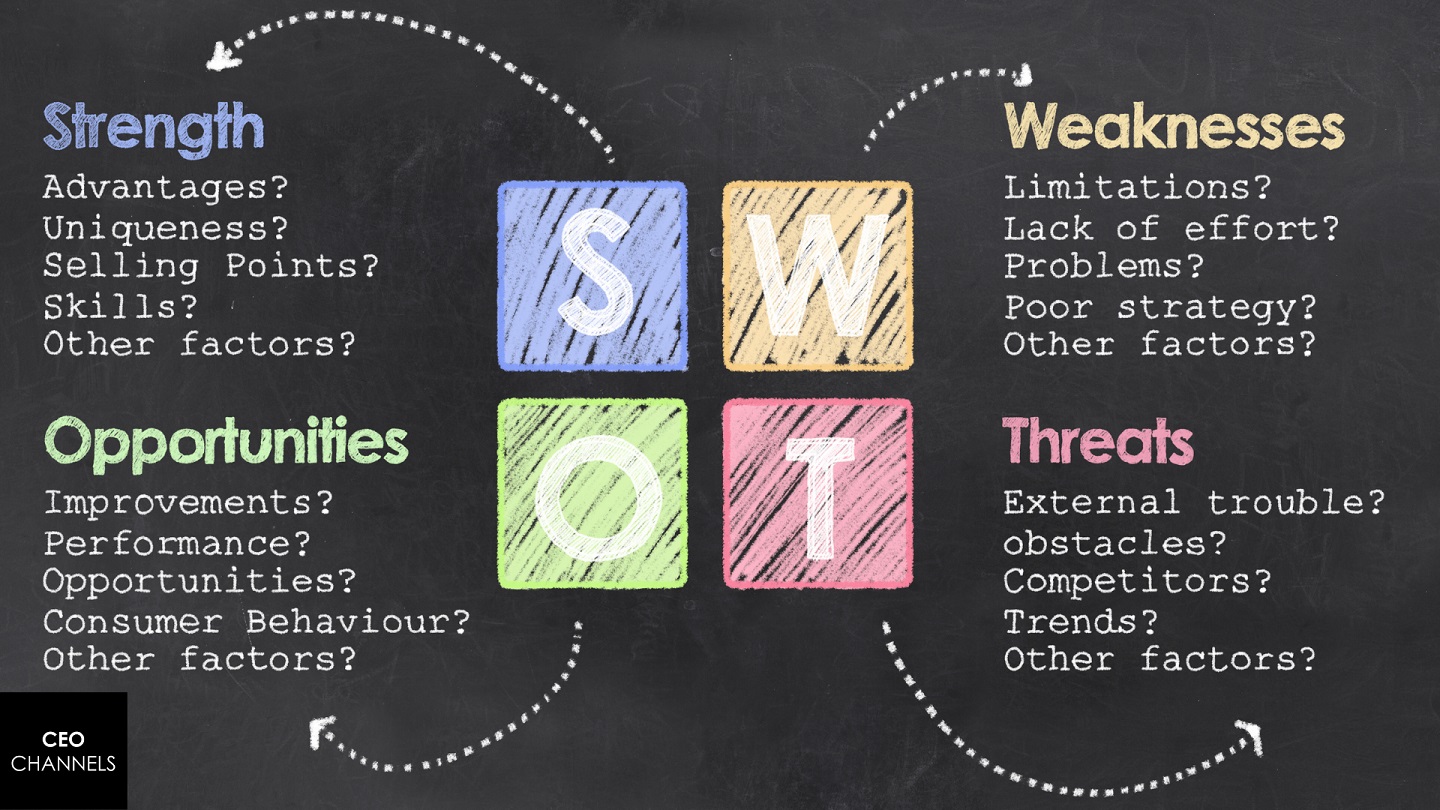SWOT analysis is a strategic planning method used to evaluate the Strengths, Weaknesses, Opportunities, and Threats involved in a business or project.
The goal of a SWOT analysis is to identify the internal and external factors that can affect the success of an organization, and to develop strategies that capitalize on its strengths and opportunities, while mitigating its weaknesses and threats.
S in SWOT stands for strengths :
Strengths refer to the positive characteristics or qualities of a business or project that give it an advantage over others.
These can include things like a strong brand, a well-trained and experienced workforce, high-quality products or services, a loyal customer base, or a unique value proposition.
In a SWOT analysis, strengths are the internal factors that can help an organization achieve its goals and objectives.
W in SWOT stands for weaknesses :
Weaknesses refer to the negative characteristics or qualities of a business or project that put it at a disadvantage compared to others.
These can include things like a lack of resources, a lack of expertise or experience, poor-quality products or services, high operating costs, or a lack of a strong brand.
In a SWOT analysis, weaknesses are the internal factors that can hinder an organization’s ability to achieve its goals and objectives.
Identifying and addressing these weaknesses can help an organization improve its overall performance and competitiveness.
O in SWOT stands for opportunities :
Opportunities refer to the external factors that can help an organization achieve its goals and objectives.
These can include things like a growing market, new technologies, changing customer needs, or favorable economic conditions.
In a SWOT analysis, opportunities are the external factors that can provide an organization with a competitive advantage and help it succeed.
Identifying and seizing these opportunities can be a key to achieving success in any business or project.
T in SWOT stands for threats :
Threats refer to the external factors that can hinder an organization’s ability to achieve its goals and objectives.
These can include things like competition, changing market conditions, new regulations, or economic downturns.
In a SWOT analysis, threats are the external factors that can pose a risk to an organization’s success.
Identifying and addressing these threats can help an organization mitigate the risks it faces and increase its chances of success.
Here are 5 Tips you can apply SWOT Analysis to your new business!
1. Identify your strengths :
In a SWOT analysis, the first step is to identify the strengths of your business.
These can include things like your unique value proposition, your experienced and talented team, your high-quality products or services, or your loyal customer base.
Identifying your strengths can help you understand what sets your business apart from others and can give you a competitive advantage.
2. Identify your weaknesses :
The next step in a SWOT analysis is to identify the weaknesses of your business.
These can include things like a lack of resources, a lack of expertise or experience, high operating costs, or poor-quality products or services.
Identifying your weaknesses can help you understand what areas of your business need improvement and can help you develop strategies to overcome them.
3. Identify your opportunities :
After identifying your strengths and weaknesses, the next step is to identify the opportunities that are available to your business.
These can include things like a growing market, new technologies, changing customer needs, or favorable economic conditions.
Identifying your opportunities can help you understand what opportunities are available to your business and can help you develop strategies to seize them.
4. Identify your threats :
The final step in a SWOT analysis is to identify the threats that your business faces.
These can include things like competition, changing market conditions, new regulations, or economic downturns.
Identifying your threats can help you understand the risks that your business faces and can help you develop strategies to mitigate them.
5. Develop a plan of action :
After completing your SWOT analysis, the next step is to develop a plan of action that capitalizes on your strengths, addresses your weaknesses, seizes your opportunities, and mitigates your threats.
This plan should include specific goals, objectives, and strategies that are designed to help your business succeed.
Implementing this plan and regularly reviewing and updating it can help your business continue to grow and thrive.
Conclusion
SWOT analysis is a useful tool for small or new businesses to evaluate their strengths, weaknesses, opportunities, and threats.
By identifying these internal and external factors, businesses can develop strategies that capitalize on their strengths and opportunities, while addressing their weaknesses and mitigating their threats.
By using a SWOT analysis, businesses can increase their chances of success and position themselves for growth and long-term success.
What is Recession : Explained Like You Are 5-Year-Old







